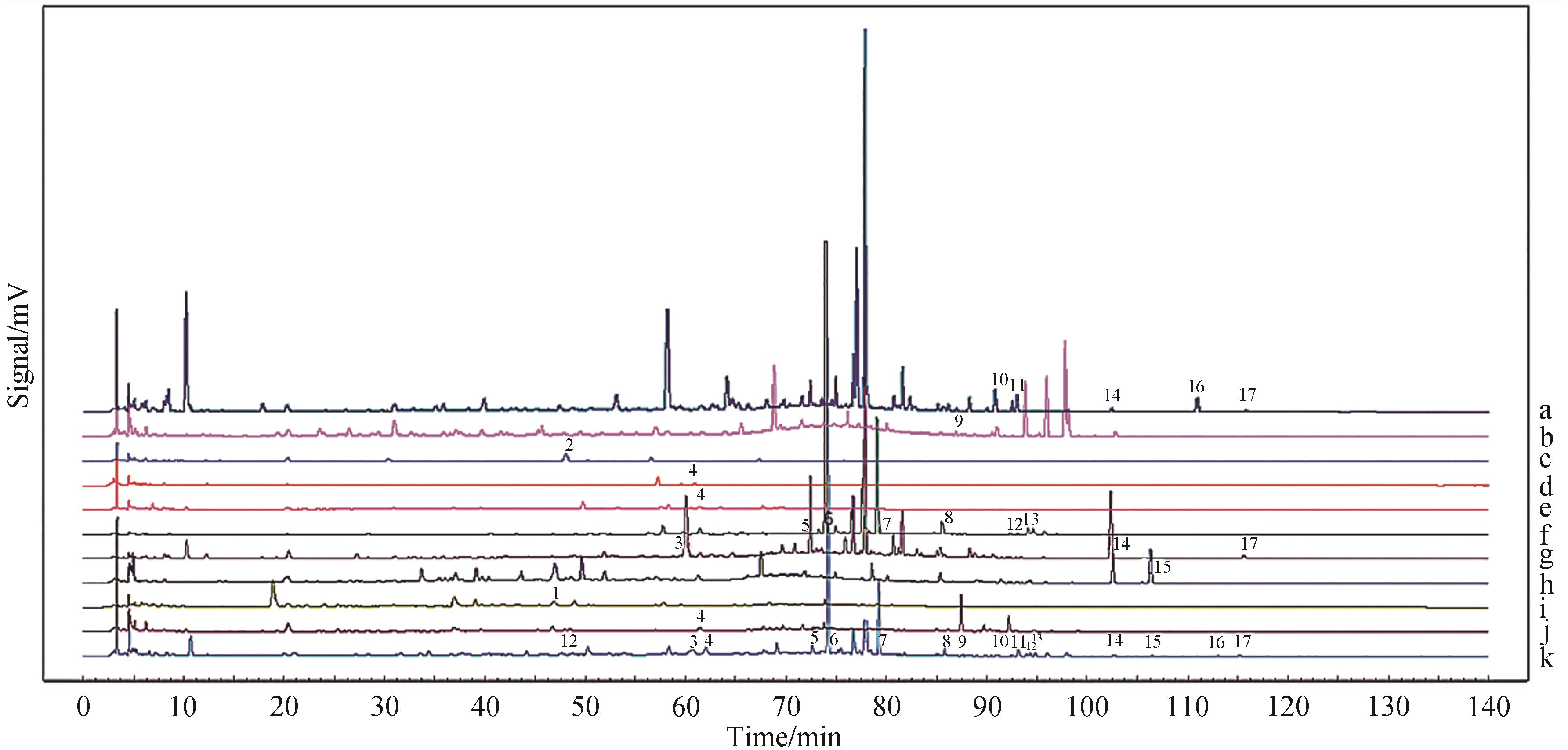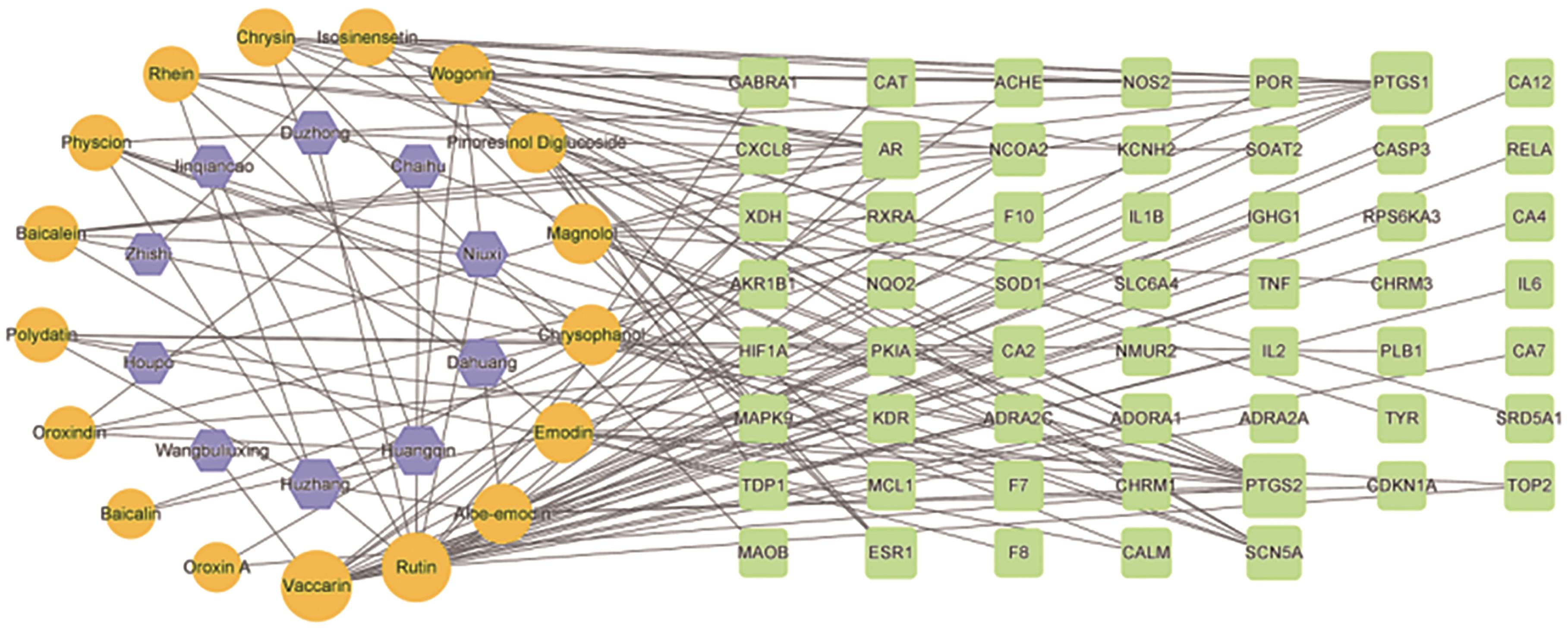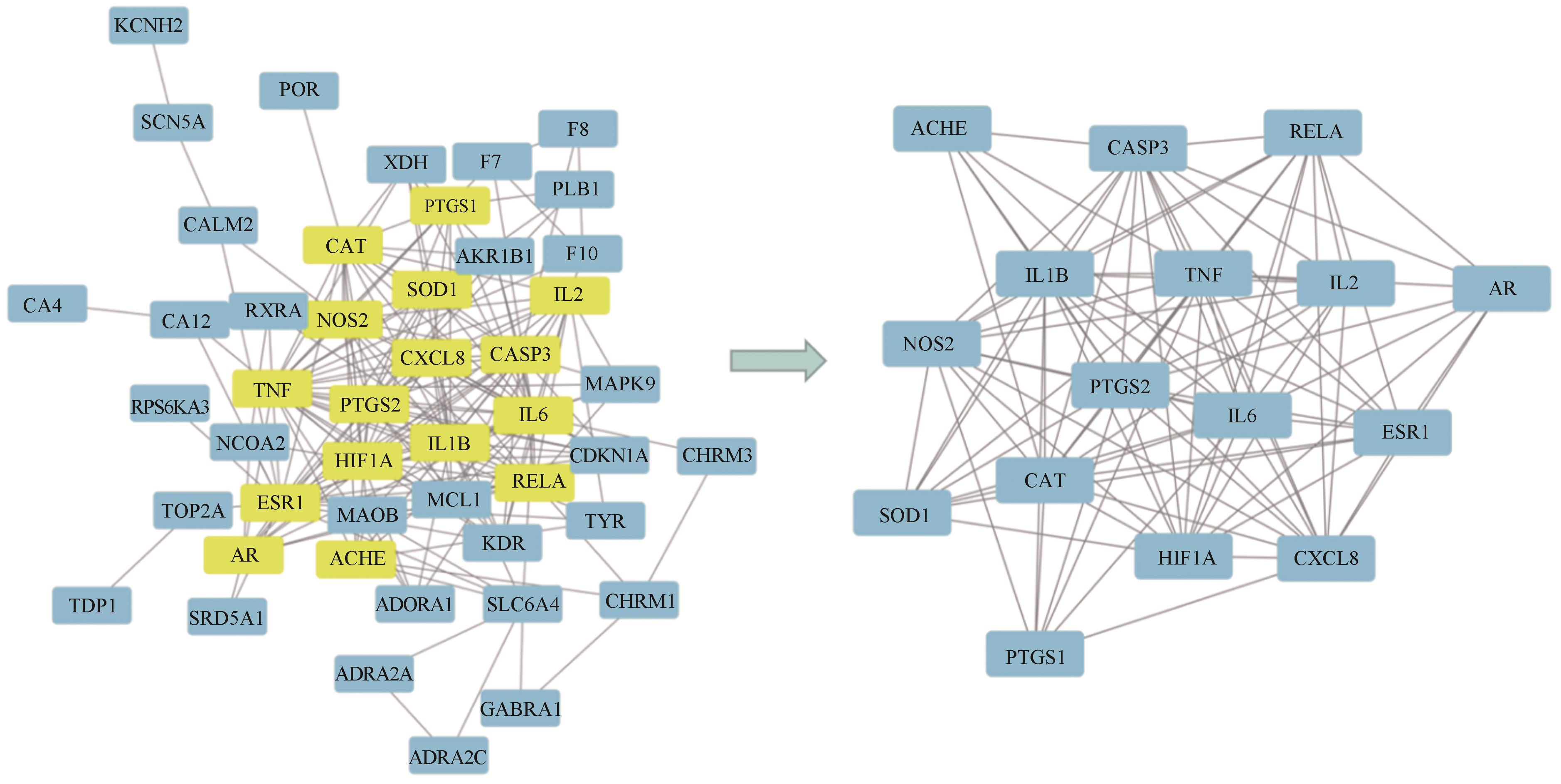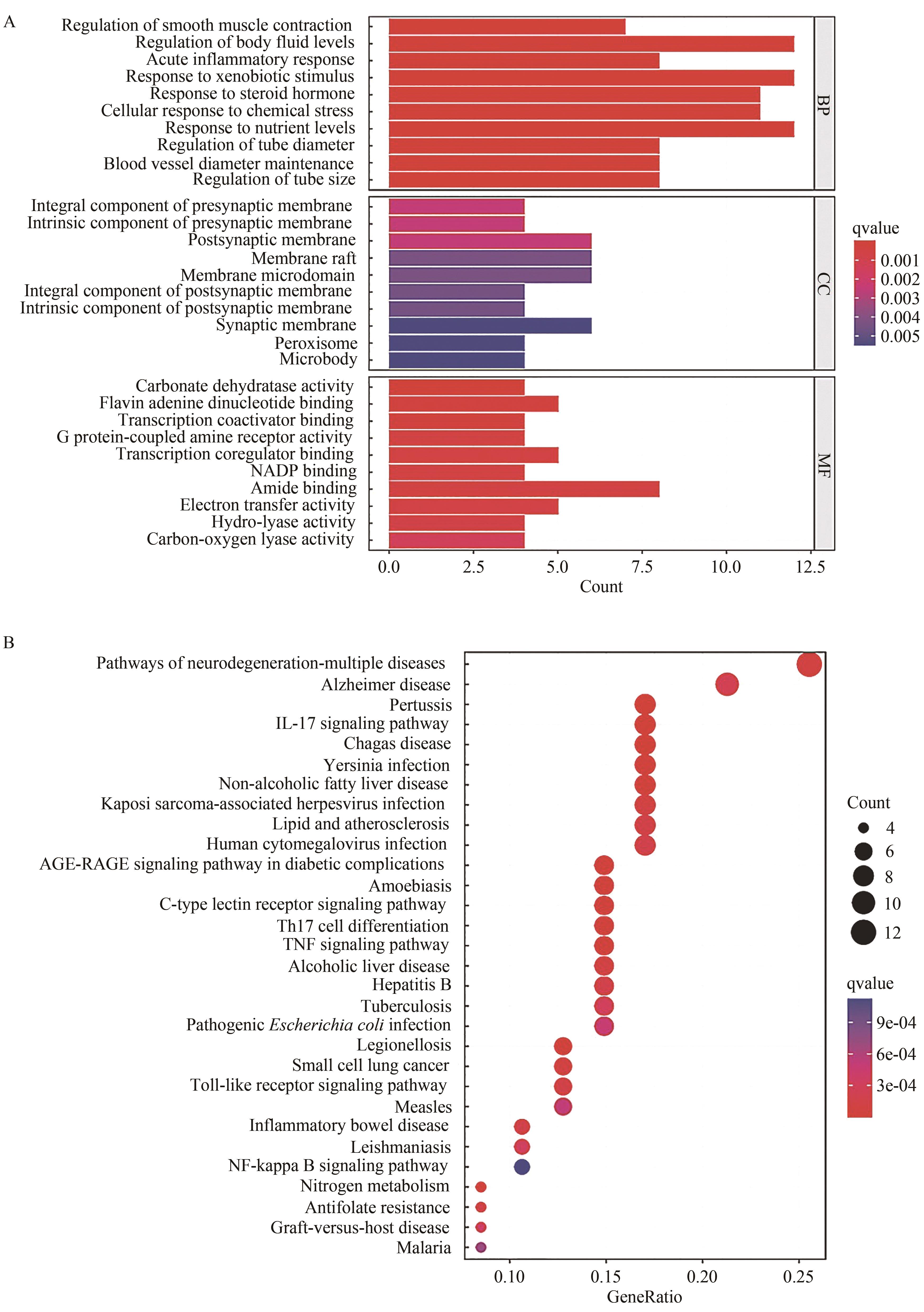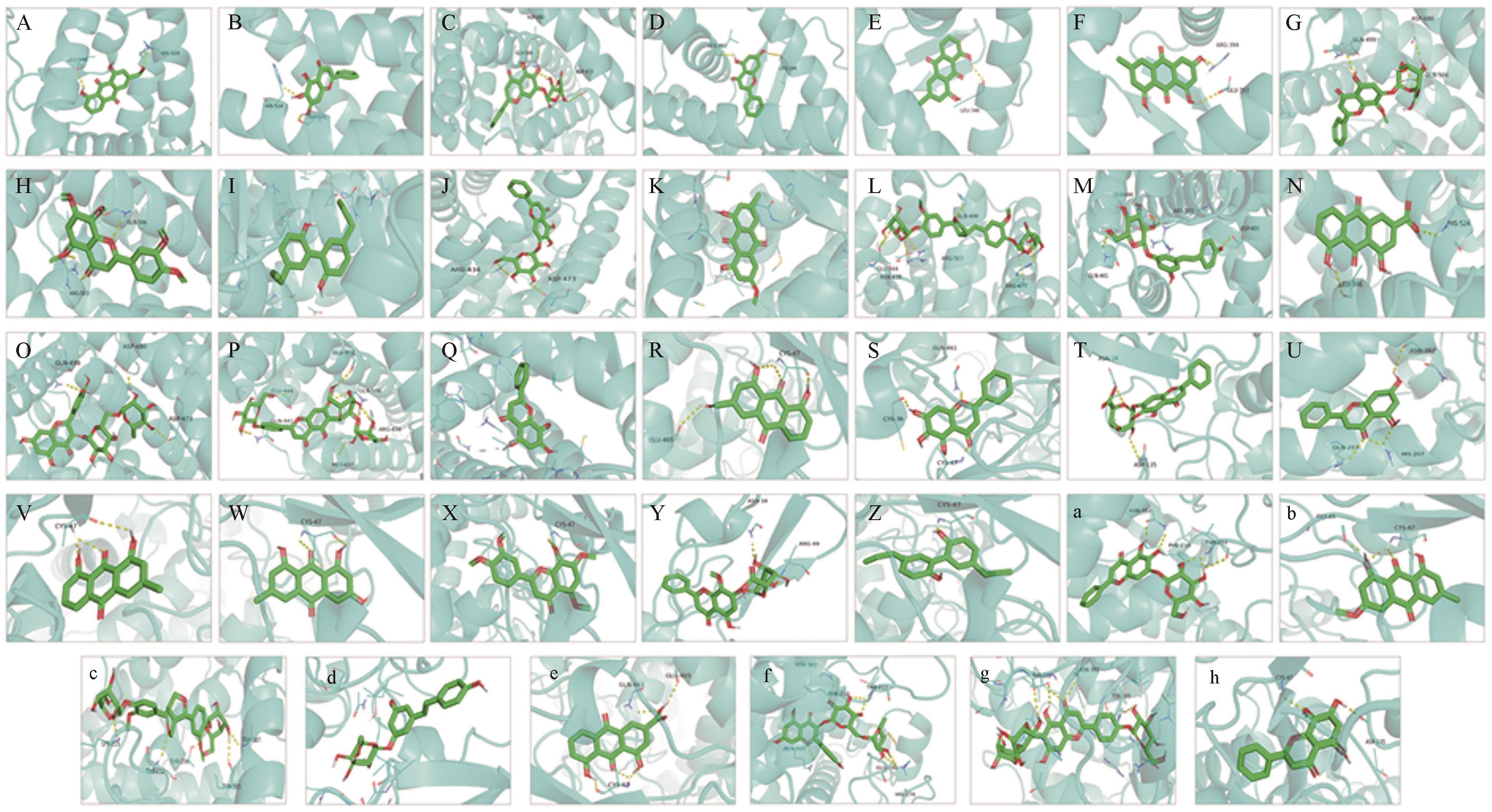
Chinese Journal of Applied Chemistry ›› 2023, Vol. 40 ›› Issue (11): 1558-1571.DOI: 10.19894/j.issn.1000-0518.230165
• Full Papers • Previous Articles Next Articles
Fingerprints and Action Mechanism of Efficacy-Associated Substances of Yishen Paishi Formula
Zhong-Yi LIU1, Cong LIU1, Yong-Fan MA1, Wei ZHAO1, Yan-Hua LIU2, Hong-Bo CHU2( )
)
- 1.School of Pharmaceutical Sciences Changchun University of Chinese Medicine,Changchun 130117,China
2.The Affiliated Hospital to Changchun University of Chinese Medicine,Changchun 130021,China
-
Received:2023-06-05Accepted:2023-10-08Published:2023-11-01Online:2023-12-01 -
Contact:Hong-Bo CHU -
About author:7377023@qq.com
-
Supported by:Jilin Provincial Natural Science Foundation(YDZJ202201ZYTS237);the Science and Technology Development Project of Jilin Province(20200404068YY)
CLC Number:
Cite this article
Zhong-Yi LIU, Cong LIU, Yong-Fan MA, Wei ZHAO, Yan-Hua LIU, Hong-Bo CHU. Fingerprints and Action Mechanism of Efficacy-Associated Substances of Yishen Paishi Formula[J]. Chinese Journal of Applied Chemistry, 2023, 40(11): 1558-1571.
share this article
Add to citation manager EndNote|Ris|BibTeX
URL: http://yyhx.ciac.jl.cn/EN/10.19894/j.issn.1000-0518.230165
| Time/min | Mobile phase B/% | Mobile phase A/% | Other conditions |
|---|---|---|---|
| 0 | 5 | 95 | Column temperature: 30 ℃ Flow rates: 0.3 mL/min Sample size: 2 μL |
| 2 | 5 | 95 | |
| 6 | 30 | 70 | |
| 7 | 30 | 70 | |
| 12 | 78 | 22 | |
| 14 | 78 | 22 | |
| 17 | 95 | 5 | |
| 20 | 95 | 5 | |
| 21 | 95 | 5 | |
| 25 | 5 | 95 |
Table 1 Gradient elution procedure of ultra performance liquid chromatography
| Time/min | Mobile phase B/% | Mobile phase A/% | Other conditions |
|---|---|---|---|
| 0 | 5 | 95 | Column temperature: 30 ℃ Flow rates: 0.3 mL/min Sample size: 2 μL |
| 2 | 5 | 95 | |
| 6 | 30 | 70 | |
| 7 | 30 | 70 | |
| 12 | 78 | 22 | |
| 14 | 78 | 22 | |
| 17 | 95 | 5 | |
| 20 | 95 | 5 | |
| 21 | 95 | 5 | |
| 25 | 5 | 95 |
| Time/min | Mobile phase B/% | Mobile phase A/% | Other conditions |
|---|---|---|---|
| 0 | 5 | 95 | Column temperature: 25 ℃ Flow rates: 1 mL/min Sample size: 10 μL Detection wavelength: 254 nm |
| 10 | 5 | 95 | |
| 25 | 10 | 90 | |
| 40 | 15 | 85 | |
| 60 | 20 | 80 | |
| 70 | 30 | 70 | |
| 80 | 40 | 60 | |
| 90 | 50 | 50 | |
| 100 | 60 | 40 | |
| 110 | 70 | 30 | |
| 120 | 80 | 20 | |
| 130 | 5 | 95 | |
| 140 | 5 | 95 |
Table 2 Gradient elution program of high performance liquid chromatography
| Time/min | Mobile phase B/% | Mobile phase A/% | Other conditions |
|---|---|---|---|
| 0 | 5 | 95 | Column temperature: 25 ℃ Flow rates: 1 mL/min Sample size: 10 μL Detection wavelength: 254 nm |
| 10 | 5 | 95 | |
| 25 | 10 | 90 | |
| 40 | 15 | 85 | |
| 60 | 20 | 80 | |
| 70 | 30 | 70 | |
| 80 | 40 | 60 | |
| 90 | 50 | 50 | |
| 100 | 60 | 40 | |
| 110 | 70 | 30 | |
| 120 | 80 | 20 | |
| 130 | 5 | 95 | |
| 140 | 5 | 95 |
| Filter conditions | Quantities |
|---|---|
| |log FC|>2 &P<0.05 | 325 |
| |log FC|>1 & P<0.05 | 6 227 |
| |log FC|>0.58 & P<0.05 | 12 316 |
Table 3 Screening results of differential genes
| Filter conditions | Quantities |
|---|---|
| |log FC|>2 &P<0.05 | 325 |
| |log FC|>1 & P<0.05 | 6 227 |
| |log FC|>0.58 & P<0.05 | 12 316 |
| Target-Active ingredients | Affinity/(kJ·mol-1) | Target-Active ingredients | Affinity/(kJ·mol-1) |
|---|---|---|---|
| ESR1-rhein | -38.49 | PTGS1-Vaccarin | -40.58 |
| ESR1-chrysin | -38.07 | PTGS1-Rutinum | -40.17 |
| ESR1-baicalein | -38.07 | PTGS1-chrysin | -38.91 |
| ESR1-emodin | -38.07 | PTGS1-rhein | -38.49 |
| ESR1-aloe-emodin | -37.24 | PTGS1-baicalein | -38.07 |
| ESR1-Chrysophanol | -37.24 | PTGS1-Wogonoside | -38.07 |
| ESR1-Vaccarin | -35.98 | PTGS1-Oroxin A | -37.66 |
| ESR1-Wogonin | -35.56 | PTGS1-Baicalin | -37.66 |
| ESR1-physcion | -35.15 | PTGS1-aloe-emodin | -37.24 |
| ESR1-Oroxin A | -33.89 | PTGS1-Chrysophanol | -37.24 |
| ESR1-Rutinum | -33.89 | PTGS1-physcion | -36.40 |
| ESR1-Baicalin | -33.47 | PTGS1-emodin | -35.98 |
| ESR1-polydatin | -33.05 | PTGS1-polydatin | -36.40 |
| ESR1-pinoresinol diglucoside | -32.22 | PTGS1-pinoresinol diglucoside | -34.73 |
| ESR1-Wogonoside | -31.80 | PTGS1-Wogonin | -34.31 |
| ESR1-Magnolol | -30.96 | PTGS1-Isosinensetin | -34.31 |
| ESR1-Isosinensetin | -28.87 | PTGS1-Magnolol | -30.96 |
Table 4 Minimum free energy of binding between core target and active ingredient
| Target-Active ingredients | Affinity/(kJ·mol-1) | Target-Active ingredients | Affinity/(kJ·mol-1) |
|---|---|---|---|
| ESR1-rhein | -38.49 | PTGS1-Vaccarin | -40.58 |
| ESR1-chrysin | -38.07 | PTGS1-Rutinum | -40.17 |
| ESR1-baicalein | -38.07 | PTGS1-chrysin | -38.91 |
| ESR1-emodin | -38.07 | PTGS1-rhein | -38.49 |
| ESR1-aloe-emodin | -37.24 | PTGS1-baicalein | -38.07 |
| ESR1-Chrysophanol | -37.24 | PTGS1-Wogonoside | -38.07 |
| ESR1-Vaccarin | -35.98 | PTGS1-Oroxin A | -37.66 |
| ESR1-Wogonin | -35.56 | PTGS1-Baicalin | -37.66 |
| ESR1-physcion | -35.15 | PTGS1-aloe-emodin | -37.24 |
| ESR1-Oroxin A | -33.89 | PTGS1-Chrysophanol | -37.24 |
| ESR1-Rutinum | -33.89 | PTGS1-physcion | -36.40 |
| ESR1-Baicalin | -33.47 | PTGS1-emodin | -35.98 |
| ESR1-polydatin | -33.05 | PTGS1-polydatin | -36.40 |
| ESR1-pinoresinol diglucoside | -32.22 | PTGS1-pinoresinol diglucoside | -34.73 |
| ESR1-Wogonoside | -31.80 | PTGS1-Wogonin | -34.31 |
| ESR1-Magnolol | -30.96 | PTGS1-Isosinensetin | -34.31 |
| ESR1-Isosinensetin | -28.87 | PTGS1-Magnolol | -30.96 |
| 1 | 石娅, 刘文, 刘兴德, 等. 基于PI3K/Akt信号通路探究当归补血汤干预大鼠实验性脑缺血再灌注损伤的作用机制[J]. 中草药, 2022, 53(16): 5052-5065. |
| SHI Y, LIU W, LIU X D, et al. Mechanism of Danggui Buxue decoction in intervention of experimental cerebral ischemia reperfusion injury in rats based on PI3K/Akt signaling pathway[J]. Chin Tradit Herb Drugs, 2022, 53(16): 5052-5065. | |
| 2 | 涂宛晴, 梁秋儿, 谢鹏程, 等. 基于TNF-α/IKKβ/NF-κB信号通路研究消积丸治疗ApoE-/-小鼠动脉粥样硬化的机制[J].中草药, 2022, 53(16): 5074-5084. |
| TU W Q, LIANG Q E, XIE P C, et al. Mechanism of Xiaoji Pills in treatment of atherosclerosis in ApoE-∕- mice based on TNF-α/IKKβ/NF-κB signaling pathway[J]. Chin Tradit Herb Drugs, 2022, 53(16): 5074-5084. | |
| 3 | 牛明, 张斯琴, 张博, 等. 《网络药理学评价方法指南》解读[J]. 中草药, 2021, 52(14): 4119-4129. |
| NIU M, ZHANG S Q, ZHANG B, et al. Interpretation of network pharmacology evaluation method guidance[J]. Chin Tradit Herb Drugs, 2021, 52(14): 4119-4129. | |
| 4 | 臧凝子, 李品, 庞立健, 等. 基于网络药理学和生物信息学筛选小青龙汤治疗支气管哮喘的关键基因和通路[J]. 中国实验方剂学杂志, 2021, 27(3): 171-183. |
| ZANG N Z, LI P, PANG L J, et al. Exploring key genes and signaling pathways in treatment of bronchial asthma with Xiao Qinglongtang based on network pharmacology and bioinformatics[J]. Chin J Exp Tradit Med Formulae, 2021, 27(3): 171-183. | |
| 5 | LIU J Q, LIU J, TONG X L, et al. Network pharmacology prediction and molecular docking-based strategy to discover the potential pharmacological mechanism of Huai Hua San against ulcerative colitis[J]. Drug Des Dev Ther, 2021, 15: 15: 3255-3276. |
| 6 | 姚令文, 刘燕, 郑笑为, 等. 指纹图谱、特征图谱技术在中药材和中成药中的应用[J]. 中国新药杂志, 2018, 27(8): 934-939. |
| YAO L W, LIU Y, ZGENG X W, et al. Application of the fingerprint and characteristic fingerprint technology in traditional Chinese medicinal materials and Chinese patent medicine[J]. Chin J New Drugs, 2018, 27(8): 934-939. | |
| 7 | 汪翔, 夏启东, 寻阳. 基于网络药理学和分子对接分析探讨五苓散治疗肾结石的潜在作用机制[J]. 广州医科大学学报, 2022, 50(5): 42-46. |
| WANG X, XIA Q D, XUN Y. Network pharmacological study and molecular docking analysis on potential mechanism of Wuling powder in treatment of kidney stone[J]. Acad J Guangzhou Med Univ, 2022, 50(5): 42-46. | |
| 8 | KIM A R, JUNG M C, JEONG H I, et al. Antioxidative and cellular protective effects of lysimachia christinae hance extract and fractions[J]. Appl Chem Eng, 2018, 29(2): 176-184. |
| 9 | KIRINO A, TAKASUKA Y, NISHI A, et al. Analysis and functionality of major polyphenolic components of polygonum cuspidatum (itadori)[J]. J Nutr Sci Vitaminol, 2012, 58(4): 278-286. |
| 10 | ZHANG H X, LIU M C. Separation procedures for the pharmacologically active components of rhubarb[J]. J Chromatogr B, 2004, 812(1/2): 175-181. |
| 11 | COSSIGNANI L, BLASI F, SIMONETTI M, et al. Fatty acids and phytosterols to discriminate geographic origin of Lycium barbarum berry[J]. Food Anal Methods, 2018, 11: 1180-1188. |
| 12 | HAN H K, VAN ANH L T. Modulation of P-glycoprotein expression by honokiol, magnolol and 4-O-methylhonokiol, the bioactive components of Magnolia officinalis[J]. Anticancer Res, 2012, 32(10): 4445-4452. |
| 13 | CHEUNG H Y, LAI W P, CHEUNG M S, et al. Rapid and simultaneous analysis of some bioactive components in Eucommia ulmoides by capillary electrophoresis[J]. J Chromatogr A, 2003, 989(2): 303-310. |
| 14 | LI X M, LIU Y, WANG S Y, et al. Identification and potential mechanism of different components from the aerial part of Bupleurum chinense DC. for epileptic treatment[J]. Nat Prod Res, 2022, 36(23): 6137-6142. |
| 15 | ZHANG J, CHOU G X, LIU Z J, et al. In vitro cytotoxicity and antioxidation of a whole fruit extract of Liquidambar formosana exerted by different constituents[J]. Eur J Med Plants, 2015, 6(1): 34. |
| 16 | 罗思妮, 彭致铖, 范倩, 等. 经典名方小承气汤中化学成分的UPLC-Q-Orbitrap-MS分析[J]. 中国实验方剂学杂志, 2021, 27(23): 1-10. |
| LUO S N, PENG Z C, FAN Q, et al. Analysis on chemical constituents in Xiao Chengqitang by UPLC-Q-Orbitrap-MS[J]. Chin J Exp Tradit Med Formulae, 2021, 27(23): 1-10. | |
| 17 | SMOOT M E, ONO K, RUSCHEINSKI J, et al. Cytoscape 2.8: new features for data integration and network visualization[J]. Bioinformatics, 2011, 27(3): 431-432. |
| 18 | 宋晓彤, 季旭明, 于华芸, 等. 小承气汤“成分-靶点-通路”的网络药理学研究[J]. 世界科学技术-中医药现代化, 2020, 22(9): 3150-3160. |
| SONG X T, JI X M, YU H Y, et al. Network pharmacology study of “ingredients-targets-pathways” of Xiaochengqi decoction[J]. Mod Traditional Chin Med Mater Med Would Sci Technol, 2020, 22(9): 3150-3160. | |
| 19 | MERING C V, HUYNEN M, JAEGGI D, et al. STRING: a database of predicted functional associations between proteins[J]. Nucleic Acids Res, 2003, 31(1): 258-261. |
| 20 | ZHANG J, XING Z H, MA M M, et al. Gene ontology and KEGG enrichment analyses of genes related to age-related macular degeneration[J]. BioMed Res Int, 2014, 2014: 450386. |
| 21 | 刘本涛, 袁彩英, 陈睿, 等. 基于GEO数据库及网络药理学研究绞股蓝治疗冠心病的作用机制[J]. 中成药, 2021, 43(10): 2885-2892. |
| LIU B T, YUAN C Y, CHEN R, et al. Mechanism of Gynostemma pentaphyllum in treating coronary heart disease based on GEO database and network pharmacology[J]. Chin Tradit Pat Med, 2021, 43(10): 2885-2892. | |
| 22 | 赵丽君, 马艳苗, 梁凯, 等. 基于芯片分析联合网络药理学探寻淫羊藿干预乳腺癌干细胞的生物标志物及靶点机制[J]. 中国实验方剂学杂志, 2021, 27(11): 195-204. |
| ZHAO L J, MA Y M, LIANG K, et al. Biomarkers and target mechanisms of epimedii folium intervention on breast cancer stem cells based on chip analysis and network pharmacology[J]. Chin J Exp Tradit Med Formulae, 2021, 27(11): 195-204. | |
| 23 | HSIN K Y, GHOSH S, KITANO H. Combining machine learning systems and multiple docking simulation packages to improve docking prediction reliability for network pharmacology[J]. PLoS One, 2018, 8(12): e83922. |
| 24 | 刘海朝, 曹敏, 解露露, 等. 雌激素抑制肾草酸钙结石形成机制的研究进展[J]. 临床泌尿外科杂志, 2021, 36(1): 72-75. |
| LIU H Z, CAO M, XIE L L, et al. Research progress on the mechanism of estrogen inhibiting the formation of renal calcium oxalate stones[J]. J Clin Urol, 2021, 36(1): 72-75. | |
| 25 | 刘海朝. 基于网络药理学补肾化石汤抗肾结石形成的机制研究[D]. 天津: 天津中医药大学, 2021. |
| LIU H Z. Study on the mechanism of Bushen Huashi Decoction against renal calculi formation based on network pharmacology[D]. Tianjin: Tianjin University of Traditional Chinese Medicine, 2021. | |
| 26 | BOURGONJE A R, ABDULLE A E, AL-RAWAS A M, et al. Systemic oxidative stress is increased in postmenopausal women and independently associates with homocysteine levels[J]. Int J Mol Sci, 2020, 21(1): 314. |
| 27 | MARCUS R, MADVIG P, CRIM M, et al. Conjugated estrogens in the treatment of postmenopausal women with hyperparathyroidism[J]. Ann Intern Med, 1984, 100(5): 633-640. |
| 28 | DOSHI S B, AGARWAL A. The role of oxidative stress in menopause[J]. J Food Sci, 2013, 4(3): 140. |
| 29 | STUBBINS R E, NAJJAR K, HOLCOMB V B, et al. Oestrogen alters adipocyte biology and protects female mice from adipocyte inflammation and insulin resistance[J]. Diabetes Obes Metab, 2012, 14(1): 58-66. |
| 30 | MOOSMANN B, BEHL C. The antioxidant neuroprotective effects of estrogens and phenolic compounds are independent from their estrogenic properties[J]. Proc Natl Acad Sci, 1999, 96(16): 8867-8872. |
| 31 | KRAMER H J M, GRODSTEIN F, STAMPFER M J, et al. Menopause and postmenopausal hormone use and risk of incident kidney stones[J]. J Am Soc Nephrol, 2003, 14(5): 1272-1277. |
| 32 | MAALOUF N M, SATO A H, WELCH B J, et al. Postmenopausal hormone use and the risk of nephrolithiasis: results from the Women's Health Initiative hormone therapy trials[J]. Arch Intern Med, 2010, 170(18): 1678-1685. |
| 33 | TURNER R J, KERBER I J. Renal stones, timing hypothesis, and eu-estrogenemia[J]. Menopause, 2012, 19(1): 104-108. |
| 34 | ASSIMOS D G. Re: activities of calcium-related ion channels during the formation of kidney stones in an infection-induced urolithiasis rat model[J]. J Urol, 2020, 203(2): 246-247. |
| 35 | TAGUCHI K, HAMAMOTO S, OKADA A, et al. Genome-wide gene expression profiling of Randall′s plaques in calcium oxalate stone formers[J]. J Am Soc Nephrol, 2017, 28(1): 333-347. |
| 36 | PARK S J, KIM J H, HA T S, et al. The role of Interleukin-23/Interleukin-17 axis in coexisting anti-glomerular basement membrane disease and lupus nephritis[J]. Saudi J Kidney Dis Transpl, 2013, 24(3): 596. |
| 37 | 王兴玥, 高冷, 戚良晨, 等. 基于网络药理学及分子对接技术研究向海雁鹅血的抗肺癌活性成分[J]. 应用化学, 2022, 39(11): 1680-1692. |
| WANG X Y, GAO L, QI L C, et al. Study on anti-lung cancer active ingredients from blood of Xianghai wild goose based on network pharmacology and molecular docking technology[J]. Chin J Appl Chem, 2022, 39(11): 1680-1692. |
| [1] | HUANG Siyu, ZHOU Yaping, LI Zou, QIN Xiaoli, LIU Ying, XIE Qingji*. Simultaneous HPLC Analysis of Five Environment Priority Pollutants of Phenols with a Wall-jet/thin-layer Electrochemical Detector [J]. Chinese Journal of Applied Chemistry, 2014, 31(01): 96-102. |
| [2] | LIU Yunan1,2, ZHANG Zhaohui1,2,3*, CHEN Xing1, CHEN Hongjun1, RAO Wei1, CAI Rong1. Preparation and Application of Melamine Magnetic Molecularly Imprinted Solid Phase Extraction Material [J]. Chinese Journal of Applied Chemistry, 2013, 30(10): 1222-1230. |
| [3] | LIU Xiaoge, WNAG Hongyan, YANG Guangyun, MAO Pu, HE Lijun, XIAO Yongmei, QU Lingbo*. Preparation and Evaluation of Carbamate Functionalized Ionic Liquid Stationary for High-performance Liquid Chromatography [J]. Chinese Journal of Applied Chemistry, 2013, 30(06): 710-715. |
| [4] | FANG Yishan, LI Laisheng*, CHEN Hong, ZHANG Yang. Study on the Quercetin-bonded Silica Gel Stationary Phase for the Separations of Polar Compounds by High-performance Liquid Chromatography [J]. Chinese Journal of Applied Chemistry, 2013, 30(01): 79-87. |
| [5] | LIANG Hua-Zheng1, YANG Shui-Ping1, CHEN Shuang-Xi1, CHEN Huan-Wen1,2*, LIU Qing3. Rapidly Fingerprinting Condiment Vegetables Using Surface Desorption Atomospheric Pressure Chemical Ionization Mass Spectrometry [J]. Chinese Journal of Applied Chemistry, 2010, 27(05): 606-610. |
| Viewed | ||||||
|
Full text |
|
|||||
|
Abstract |
|
|||||

